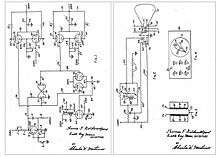Cathode-ray tube amusement device
 Circuitry schematic from the patent | |
| Type | Interactive electronic game |
|---|---|
| Inventor |
Thomas T. Goldsmith, Jr. Estle Ray Mann |
| Materials | cathode ray tube, oscilloscope |
The cathode-ray tube amusement device is the earliest known interactive electronic game. The device simulates an artillery shell arcing towards targets on a cathode ray tube (CRT) screen, which is controlled by the player by adjusting knobs to change the trajectory of a CRT beam spot on the display in order to reach plastic targets overlaid on the screen. Thomas T. Goldsmith, Jr. and Estle Ray Mann constructed the game from analog electronics and filed for a patent in 1947, which was issued the following year. The gaming device was never manufactured or marketed to the public, so it had no effect on the future video game industry. Under most definitions, the device is not considered a video game, as while it had an electronic display it did not run on a computing device. Therefore, despite its relevance to the early history of video games, it is not generally considered a candidate for the title of first video game.
Gameplay
The cathode-ray tube amusement device consists of a cathode ray tube connected to an oscilloscope with a set of knobs and switches. The device uses purely analog electronics and does not use any digital computer or memory device or execute a program.[1] The CRT projects a spot on the oscilloscope display screen, which traces a parabolic arc across the screen when a switch is activated by the player. This beam spot represents the trajectory of an artillery shell. Overlaid on the screen are transparent plastic targets representing objects such as airplanes. At the end of the spot's trajectory, the beam defocuses, resulting in the spot expanding and blurring. This represents the shell exploding as if detonated by a time fuze. The goal of the game is to have the beam defocus when it is within the bounds of a target. Prior to the beam spot beginning its arc, the player can turn the control knobs to direct the beam spot's trajectory and adjust the delay of the shell burst. The machine can be set to fire a "shell" either once or at a regular interval, which is adjustable by the player. This gives the player the goal of hitting one of the overlay targets with the shell burst within a time limit.[2]
History
The cathode-ray tube amusement device was invented by physicists Thomas T. Goldsmith, Jr. and Estle Ray Mann. The pair worked at television designer DuMont Laboratories specializing in the development of cathode ray tubes that used electronic signal outputs to project a signal onto television screens.[1] Goldsmith, who had received a Ph.D. in physics from Cornell University in 1936 with a focus on oscilloscope design, was at the time of the device's invention the director of research for DuMont Laboratories in New Jersey.[3] The two inventors were inspired by the radar displays used in World War II, which Goldsmith had worked on during the war.[1][4] The patent for the device was filed on January 25, 1947 and issued on December 14, 1948.[2] The patent, the first for an electronic game,[5] was never used by either the inventors or DuMont Laboratories, and the device was never manufactured beyond the original handmade prototypes.[6][7] Goldsmith did not work on games after the invention of the device; he was promoted to vice president in 1953 and left DuMont to become a professor of physics at Furman University in 1966.[4]
Despite being a game that used a graphical display, the cathode-ray tube amusement device is generally not considered under most definitions to be a candidate for the first video game, as it used purely analog hardware and did not run on a computing device; some loose definitions may still consider it a video game, but it is still usually disqualified as the device was never manufactured.[8][9] Nevertheless, it is the earliest known interactive electronic game as well as the first to incorporate an electronic display, thus making it a forerunner to other games in the early history of video games. As the device was never manufactured, however, it did not directly inspire any other games and had no impact on the future video game industry.[1][6]
See also
References
- 1 2 3 4 Cohen, D. S. "Cathode-Ray Tube Amusement Device". About.com. IAC. Archived from the original on 2015-09-06. Retrieved 2012-05-29.
- 1 2 US patent 2455992, Goldsmith Jr., Thomas T. & Mann, Estle Ray, "Cathode Ray Tube Amusement Device", issued 1948-12-14
- ↑ "3 Promoted by DuMont; Officials of Laboratories Are Made Vice Presidents". New York Times. 1953-11-23.
- 1 2 "IEEE History Center: Thomas Goldsmith Abstract". IEEE History Center. Institute of Electrical and Electronics Engineers. 1973-05-14. Archived from the original on 2008-12-09. Retrieved 2015-01-02.
- ↑ Silberman, Gregory P. (2006-08-30). "Patents Are Becoming Crucial to Video Games". The National Law Journal (ALM). ISSN 0162-7325.
- 1 2 Wolf, Mark J. P. (2012-06-05). Before the Crash: Early Video Game History. Wayne State University Press. pp. 1–2. ISBN 978-0-8143-3450-8.
- ↑ Donovan, Tristan (2010-04-20). Replay: The History of Video Games. Yellow Ant. pp. 1–9. ISBN 978-0-9565072-0-4.
- ↑ Kowert, Rachel; Quandt, Thorsten (2015-08-27). The Video Game Debate: Unravelling the Physical, Social, and Psychological Effects of Video Games. Routledge. p. 3. ISBN 978-1-138-83163-6.
- ↑ Wolf, Mark J. P. (2012-08-16). Encyclopedia of Video Games: The Culture, Technology, and Art of Gaming. Greenwood Publishing Group. pp. 3–7. ISBN 978-0-313-37936-9.
| ||||||||||||||||||